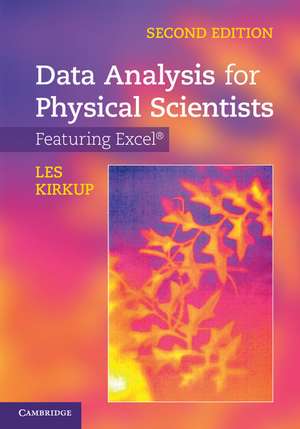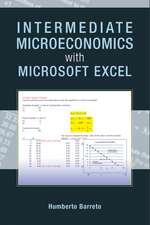Data Analysis for Physical Scientists: Featuring Excel®
Autor Les Kirkupen Limba Engleză Hardback – 15 feb 2012
Preț: 562.68 lei
Preț vechi: 632.23 lei
-11% Nou
Puncte Express: 844
Preț estimativ în valută:
107.68€ • 112.01$ • 88.90£
107.68€ • 112.01$ • 88.90£
Carte tipărită la comandă
Livrare economică 14-28 aprilie
Preluare comenzi: 021 569.72.76
Specificații
ISBN-13: 9780521883726
ISBN-10: 0521883725
Pagini: 528
Ilustrații: 149 b/w illus. 214 exercises
Dimensiuni: 180 x 253 x 29 mm
Greutate: 1.18 kg
Ediția:Revised
Editura: Cambridge University Press
Colecția Cambridge University Press
Locul publicării:Cambridge, United Kingdom
ISBN-10: 0521883725
Pagini: 528
Ilustrații: 149 b/w illus. 214 exercises
Dimensiuni: 180 x 253 x 29 mm
Greutate: 1.18 kg
Ediția:Revised
Editura: Cambridge University Press
Colecția Cambridge University Press
Locul publicării:Cambridge, United Kingdom
Cuprins
1. Introduction to scientific data analysis; 2. Excel and data analysis; 3. Data distributions I; 4. Data distributions II; 5. Measurement, error and uncertainty; 6. Least squares I; 7. Least squares II; 8. Non-linear least squares; 9. Tests of significance; 10. Data analysis tools in Excel and the Analysis ToolPak; Appendixes; Answers to exercises and end-of-chapter problems; References; Index.
Recenzii
Reviews of the first edition: 'This book is extremely well structured. It both describes the main functionality of Excel with special emphasis on scientific data analysis, as well as the statistical background to the methods … definitely one of the best on the market in this important area … the author should be congratulated on doing a wonderful job.' Richard Brereton, Chemistry Industry
'Overall, I found the book excellent.' S. Middleton, The Physicist
Review of previous edition: '… a simple and straightforward introduction to the use of spreadsheet calculations and data display … The coverage of this book will be more than adequate for undergraduate courses and will be sufficient for many postgraduate and research readers … a good introduction to Excel® for data analysis for the first time user and covers the data analysis methods that most physical scientists will need.' B. W. James, Contemporary Physics
'The fundamental observation of experimental science is that repeated measurements of the same quantity by the same person using the same equipment do not repeatedly give the same value. … Thus, statistical analysis of experimental data is a large part of experimental physics … [This book] deals with all these problems at a level appropriate to an undergraduate course on data analysis. … introduces useful ideas and many examples on data visualisation, with examples chosen from many fields of science … data distributions, and their results are then exploited in a very extensive discussion of experimental errors. … and provides useful information on how to combine random and calibration errors … The rest of the book applies these statistical methods to the bread and butter of experimental data analysis - linear and non-linear least squares curve fitting, and hypothesis testing. The theoretical basis is given, and its numerical implementation through Excel® described.' P. T. Greenland, Contemporary Physics
'Overall, I found the book excellent.' S. Middleton, The Physicist
Review of previous edition: '… a simple and straightforward introduction to the use of spreadsheet calculations and data display … The coverage of this book will be more than adequate for undergraduate courses and will be sufficient for many postgraduate and research readers … a good introduction to Excel® for data analysis for the first time user and covers the data analysis methods that most physical scientists will need.' B. W. James, Contemporary Physics
'The fundamental observation of experimental science is that repeated measurements of the same quantity by the same person using the same equipment do not repeatedly give the same value. … Thus, statistical analysis of experimental data is a large part of experimental physics … [This book] deals with all these problems at a level appropriate to an undergraduate course on data analysis. … introduces useful ideas and many examples on data visualisation, with examples chosen from many fields of science … data distributions, and their results are then exploited in a very extensive discussion of experimental errors. … and provides useful information on how to combine random and calibration errors … The rest of the book applies these statistical methods to the bread and butter of experimental data analysis - linear and non-linear least squares curve fitting, and hypothesis testing. The theoretical basis is given, and its numerical implementation through Excel® described.' P. T. Greenland, Contemporary Physics
Notă biografică
Descriere
Introducing data analysis techniques to help undergraduate students develop the tools necessary for studying and working in the physical sciences.



